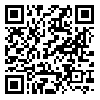BibTeX | RIS | EndNote | Medlars | ProCite | Reference Manager | RefWorks
Send citation to:
URL: http://jha.iums.ac.ir/article-1-91-en.html
Introduction: Time restraint, heavy workload, limitation of diagnostic procedures and Urgency in selecting treatment Method are among the remarkable features of working in emergency units. These points, along with other particular problems in a selected emergency largest referral unit in Glean/province were our driving force to document the weaknessess by using statisties and information and propose a strategy to improve the quality of health care rendered to patients.
Methods: In a cross-sectional study conducted within a month period, the quality health of services rendered to all referrals in emergency units expect, infant emergency unit, gyneochological and obsterics (O.B.G), and psychiatric cases were studied, Acriterian based questionnaire was designed to be completed by the observer, then data were tallied statistically by computer.
Finbings: The number of referrals to the emergency department whilst the study was being conducted amounted to 2815.Or on the average (84 daily).59.2 percent personally referred, 40.8 percent were referrals from other centers or offices, 42.3 percent were hospitalized and 57.7 percent were treated as outpatients. The mean time spent for each diagnostic and treatment procedurals was as follows: The average time spent by trainers was 29 minutes, the time patient entered the unit until he was actually admitted took 55 minutes, record filling was 16 minutes, prescripitonal procedures 16 minutes, transfer time to the other departments 18 minutes, the time the emergency patient entered the ward (after diagnosis and treatment procedurals) till he got the prescription 118 minutes, lab results took 97 minutes. EKG results 11 minutes, sonography results 48 minutes, C.T scan from reqursting to return the result took 27 minutes. During Shahrrivar month in 1381, orthopedic and surgical wards had the most admissions (39.1and 28.8 respectably). Resident aids in the screening room at the emergency department were mostly anesthesists an surgeon aids all inal only 10.2 percent of the sceener's field of specialty matched the referees' cases. The average CPR and death cases in emergency unit was 2.5 and 2 respectably. Early diagnosis in 34% of the cases were correct and 5.4 percent were wrong. 42.8% of cases the final dignosis was determined by only one sign or indication. In 15.1% of the cases, there existed an ambiguity in the patient's diagnosis. The most crowded referral time estimated to have between 4 to 12p.m (49.4%).
Results: considering the results, the procedures which hinderd the work flow in the selected center include: diagnositic tests, making decisions on admission, orders, filing procedures. Other shortcomings of the selected center are lack of adequate space and great number of emergency referrals, inconsistency of the aid's major field of study to the referrals actual medical complaint, and the absence of documentation of final diagosis in some cases.
Received: 2008/08/10 | Published: 2005/01/15
| Rights and permissions | |
 |
This work is licensed under a Creative Commons Attribution-NonCommercial 4.0 International License. |





